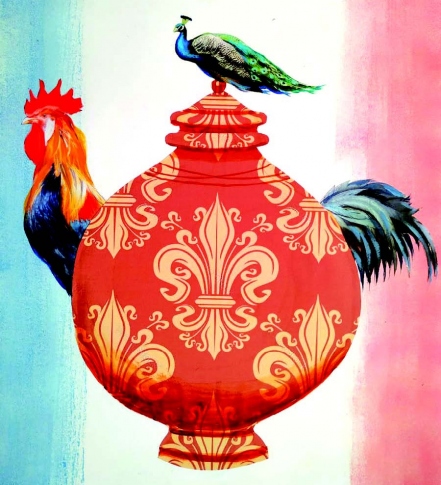
Vivek Menezes
An old and significant cultural crossroads hits another high point in its revival this evening, with the first edition of Thinnai Stories, an online series of conversations hosted by the distinguished Indo-Malagasy writer Ari Gautier (who lives in Norway) and Goa’s own Shamika Andrade from the Alliance Française in Panjim. The new initiative debuts most impressively with Ananda Devi, the hugely acclaimed Mauritian winner of the 2024 Neustadt International Prize for Literature – “the American Nobel” – who is one of the most important Francophone literary voices. Attendance is free via Zoom: Meeting ID 966 7123 6147 and passcode 7Wxe0Y.
Gautier and Andrade are mining rich terrain, of an intense intellectual back-and-forth that has persisted between France and Goa for 250 years, although largely overlooked in the myopic contemporary narrative which misinterprets and falsely represents Pondicherry as the be-all and end-all of French impact and ideas in India. In fact, what occurred between Paris and Panjim is much more consequential than the cultural history of that still-quaint Union Territory – it has so far handled tourism relatively well – where the streets are named for icons like Alexandre Dumas and Romain Rolland, even if those luminaries had living links to Goa no other place in South Asia can rival.
Here, it’s interesting to note how the colonial history prism is itself quite misleading when assessing what happened between France and Goa from the 18th century onwards. Instead, what comes across is a meaningful mutual solidarity about the sacred principles of equality and self-determination, which the Goans have always quickly absorbed and adapted from every global cross-current after the advent of the Estado da India in 1510. This much is amply clear: following the 1789 French Revolution, the Goan quest for liberation assimilated the language of Robespierre - liberté, égalité, fraternité – and France became Goa’s primary intellectual lodestar (as was the case for Portugal as well), while formidable pioneers from this tiny slice of the Konkan ventured across to Europe to make history in France. The first, of course, was the enigmatic “Abbé” José Custódio de Faria who relocated to post-revolutionary Paris precisely to scheme against the Portuguese, and cut such a dramatic public figure that Alexandre Dumas was moved to immortalize him in Le Comte de Monte-Cristo.
There are many similar examples. The “father of Goan nationalism” Tristão de Bragança Cunha was effectively the Indian national movement’s first ambassador in Paris in the 1920s, where he was Ho Chi Minh’s roommate, and is credited with taking the message of Gandhi directly to Romain Rolland. Before him was Francisco Luis Gomes, the true intellectual forebear of Ambedkar, whose anti-caste 1866 novel Os Brahamanes was inscribed “Liberty, Equality and Fraternity are the necessary principles: eternal in their duration and universal in their application.” This great polymath argued (in French, of course) with Alphonse de Lamartine that “the nightingale has lost its voice whose strains once reverberated to the heavens. I demand for India, liberty and light!” His adulatory reception in Paris in 1867 - including at the palace of Napoleon III – would have been entirely unthinkable for any other Asian of the times.
Ari Gautier says France has always looked at India through an inherently dubious and bizarrely coloured lens: “The impressive work done by Professor Ian Magadera and his team at the University of Liverpool shows just how much India has been described for centuries as an exotic land of Maharajas, fakirs, snake charmers and dacoits (https://frenchbooksonindia.com/). India is the country where the French either describe human misery or rave about jungles and palaces. There are very few who have accurately understood this complex country, and until quite recently, many even wrote books about India while sitting on the banks of the Seine. Very recently, some writers have been trying hard not to make the same mistakes, but there’s still a long way to go before we can see India in French literature with any degree of accuracy.”
By himself, Gautier constitutes a one-man corrective mission, and antidote to the tired old tropes the French insist on imposing on India. Via email, he explained the selective blindness began “in the wake of [the Enlightenment] philosophers and scholars, when French intellectuals of the 19th century were charmed with India which they perceived as the land of reveries and spirituality. To writers like Voltaire, Lamartine, Stendhal, Michelet, Chateaubriand and Victor Hugo, it offered mysticism, The Upanishads, Sanskrit and eternal wisdom which Europe had lost. A whole generation of writers wrote about India without ever having set foot on Indian soil, by creating an imaginary world that continues to this day, an India crafted purely out of the French imagination.”
This is an unhelpful and unproductive approach, says Gautier: “At the beginning of the colonial era France had taken a predominant place in the subcontinent, but then lost everything except the five trading posts of Pondicherry, Karaikal, Mahe, Yanaon and Chandernagor. These tiny posts were no match for the vast expanse governed by the English, and France could have tried to win an intellectual and cultural victory instead, for that was its stated objective.” But it never happened, except to some extent in the one part of India that was similarly open to the crosscurrents of the day, while remaining free of the British jackboot. This is how and why France remained omnipresent in Portuguese India (and vice versa) in endlessly interesting ways, including constant population and cultural exchanges: “When the French first settled in Pondicherry, they were not allowed to marry Tamil women, so they sought alliances in Goa. Traces of these unions can still be seen in Pondicherry and in France. We also shared the same culinary heritage, which I talk about in all my books.”
Via email from Norway, Gautier told me “it is impossible to dissociate the history of Goa from the French presence in India and the Indian Ocean. In fact, in my next novel, I’ll be telling the incredible story of how Portuguese Indian women settled the island of Reunion. Of the 37 women considered the grandmothers of the Reunionese, 7 were European, 15 were Madagascan and 15 were Portuguese Indians. Dominique Dos Rosarios, Andrée Teixeira, Monique Pereira were among them.” It’s just one more astonishing footnote in the complex oceanic exchanges that are too often sorted and studied in ahistorical Anglophone, Francophone and Lusophone silos, but - as Thinnai Stories hopes to explore - if you look just beyond the obvious, it’s perfectly clear they are all inextricably interconnected.
It was earlier this year at the Goa Arts + Literature Festival 2024 when Gautier met Shamika Andrade of the Alliance Française in Panjim, which now operates from the late Percival Noronha’s lovely heritage home in Fontainhas. She says Thinnai Stories came from the Pardon My French initiative of the French Embassy and its Institut Français in New Delhi, where “French corners” were introduced in bookshops around the country including The Dogears Bookshop in Margao: “right from the beginning, the growth of this project has been organic, becoming bigger each month. I want to create more awareness via talks, exhibitions, and art. The world is watching us, and it’s so important to
share this France in India history from the Goan connect.”
